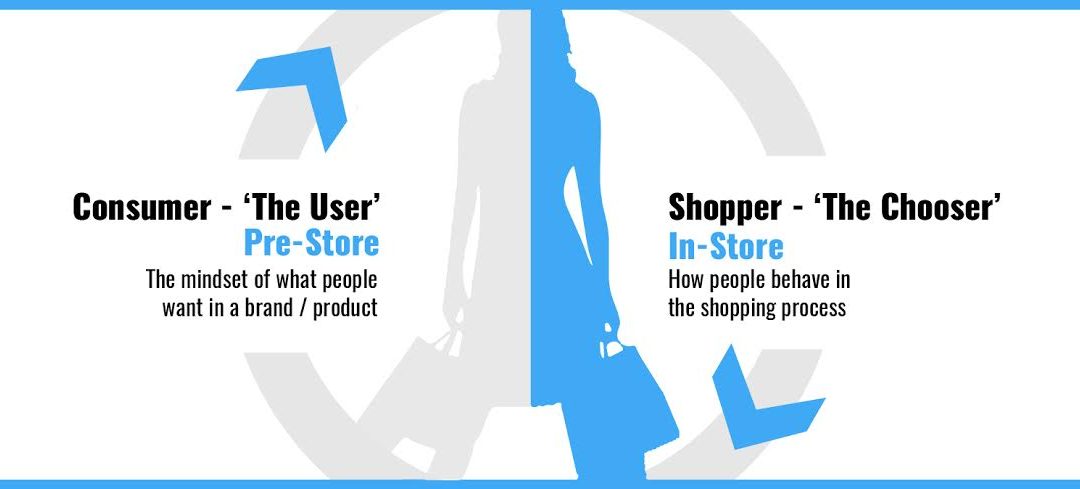In an age where customers are king, marketers constantly have to strive to keep ahead of the marketplace adapting how they interact and engage with customers to drive brand loyalty and sales growth.
How we perceive customers at different stages in the decision and buying process has led to a distinction between the consumer and the shopper which has inevitably led to differing opinions on how this should affect the marketing process and whether this is the correct approach.
A consumer is defined as a person who purchases goods and services for personal use. The marketing world is becoming more focused on connecting with consumers directly, making the experience personal and the consumer feeling valued and important.
Up until recently marketers have focused their attention on consumers, understanding who they are and how they behave, undertaking customer profiling and segmentations to enable brands to align their products and services to meet specific needs.
However, marketers have now come to understand that a consumer can be motivated or influenced when they are in the process of shopping and so the age of ‘shopper marketing’ was born. Many organisations spend over 8% total sales on in-store marketing, when total trade spend is added up it can often top 40% of total revenue.
Shopper marketing is defined as “understanding how one’s target consumers behave as shoppers, in different channels and formats, and leveraging this intelligence to the benefit of all stakeholders, defined as brands, consumers, retailers and shoppers.” Wikipedia
Shopper marketing is in essence the use of shopper insights to develop marketing campaigns that seek to influence shopper behaviour at the point of purchase. There is becoming a real split between consumer marketing and shopper marketing but is this at risk of providing insight of two halves?
Dina Howel Worldwide CEO, Saatchi & Saatchi believes it is important to understand the difference between a consumer and shopper. She states “When you are in the shower and using shampoo, you are a consumer. When the shampoo runs out, you go into shopping mode and become a shopper. That is when the emotional drivers of shopping kick in and you have the chance to connect with the shopper”.
It requires understanding of those drivers and how to connect with them in a manner that leads shoppers to purchase. Shopper marketing’s effectiveness is measureable through business results.
Along the same lines of thought, Smart Revenue believe understanding the purchase decisions begins with identifying the difference between the consumers and shoppers. “Our involvement and engagement in a category as shoppers does not tie neatly to our consumer type. Each individual shopper has different needs, wants, likes and dislikes, so retailers and suppliers need to analyze what decisions are made pre-store and what decisions are made in-store”.
So are marketers in danger of working in silos and not viewing people as a combination of both?
Fern Grant, SVP strategic planning for MARS Advertising makes the case for a holistic view that puts the ‘person’ at the centre of the discussion rather than into boxes of shopper or consumer depending on where they are along the path to purchase. She adds that people don’t view themselves as consumers or shoppers and that if agencies do the same they would be better able to leverage the wealth of insights that is available to influence behaviour.
“Shopper marketing is about change and getting the shopper to do something she isn’t currently doing,” Grant said. Insights gleaned from data fuel the process. “Data tells me what people are doing today whereas insights tell you what they are going to do tomorrow how they might do things differently if you engage with them differently.”
Brands are now too focused on consumers, while retailers want to understand their customers and that can detract from understanding people as human beings. In the agency world people are focused on consumers who talk about things like brand equity and consumer segmentation while those on the shopper team talk about basket, trips, trip type and list-making, according to Grant.
Our experiences as a consumer can prompt a different shopper experience and our experience as a shopper can influence us as consumers.”
So how do we approach this shopper and consumer debate?
As Wittemen and La Rock put it so simply in ‘Brand to Retail’ (The Hub Magazine): “There is no such thing as consumer marketing or shopper marketing. There’s only good marketing by driving brand equity all the way to the point-of-purchase wherever that may be – at home, away from home, or at retail.”
If consumers are shoppers and shopper are consumers then shouldn’t we understand who they are, how they behave and what factors might be influencing them at the decision making stage right through to the motivational factors during the shopping process.
 Serendipity2’s CEO Pete Flood states “We believe in putting customers at the very centre of the decision making process. Core to this philosophy is the belief that data is the engine which drives all forms of marketing activity whether a consumer profile, segmentation or shopper marketing indicators. A holistic view encompassing all aspects of a person’s buying process has to put us in a better position to drive sales and growth.”
Serendipity2’s CEO Pete Flood states “We believe in putting customers at the very centre of the decision making process. Core to this philosophy is the belief that data is the engine which drives all forms of marketing activity whether a consumer profile, segmentation or shopper marketing indicators. A holistic view encompassing all aspects of a person’s buying process has to put us in a better position to drive sales and growth.”
For a free consultation to understand your shoppers and consumers contact us – shopper marketing enquiry!

